The complexity and sophistication of cyber threats have increased in the contemporary era of broad digital connectivity, necessitating a proactive and alert approach to protect sensitive data. The increasing dependence on digital platforms for communication, commerce, and data storage highlights the critical need for efficient risk mitigation in cybersecurity. Proactive steps to detect, evaluate, and resolve possible risks to information systems and data integrity are part of cybersecurity risk mitigation. This proactive approach is essential for reducing the effects of successful breaches as well as preventing cyberattacks. A carefully thought-out risk mitigation plan is essential in this dynamic environment to protect the privacy, availability, and integrity of digital assets, foster trust, and maintain the resilience of our globalized society.
Privacy
Privacy is a critical benefit of risk mitigation since it emphasizes safeguarding people’s personal data from misuse and illegal access. A strong privacy-centric strategy focuses on ethical data handling, minimizes the collecting of sensitive information, and implements safeguards that go beyond simple regulatory compliance. To protect privacy, encryption, access controls, and data anonymization are essential because they guarantee that personal information is only accessible to those who are permitted. Transparency and unambiguous disclosure about data processing procedures also increase user awareness and trust. Organizations that prioritize privacy concerns in cybersecurity risk mitigation plans not only strengthen their defenses against possible intrusions, but also show a dedication to upholding individuals’ fundamental rights in an increasingly linked world.
Trust
Trust is the bedrock upon which effective cybersecurity risk mitigation strategies are built, forming the cornerstone of the relationship between individuals, organizations, and their digital ecosystems. In the dynamic landscape of cyberspace, users must trust that their sensitive information is handled with the utmost care and that robust security measures are in place to protect against potential threats. Establishing and maintaining this trust involves transparent communication about security practices, providing assurances regarding the confidentiality and integrity of data, and demonstrating a commitment to continuous improvement in the face of evolving cyber threats. Trust in cybersecurity is a reciprocal arrangement; as users entrust their data to organizations, those entities must reciprocate by investing in cutting-edge technologies, implementing best practices, and fostering a culture of security awareness. Ultimately, a foundation of trust not only fortifies defenses against cyber threats but also enhances the overall resilience of digital systems and propagates confidence in the interconnected world we inhabit.
Integrity of digital assets
Preserving the integrity of digital assets is an anchor in cybersecurity risk mitigation efforts, as it ensures that data remains accurate, unaltered, and trustworthy throughout its lifecycle. Cyber adversaries often seek to manipulate or compromise the integrity of digital information to deceive, disrupt, or gain unauthorized access. Robust cybersecurity strategies must employ mechanisms such as cryptographic controls, checksums, and secure coding practices to detect and prevent unauthorized alterations to data. Regular monitoring and validation processes are essential for identifying anomalies and ensuring the consistency of digital assets. By prioritizing the integrity of digital information, organizations not only mitigate the risk of data tampering but also bolster the overall reliability and credibility of their digital infrastructure, fostering a secure and resilient environment in the face of evolving cyber threats.

